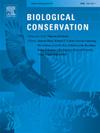钢丝陷阱偷猎的全球威胁:影响和研究重点的全面审查
IF 4.4
1区 环境科学与生态学
Q1 BIODIVERSITY CONSERVATION
引用次数: 0
摘要
钢丝陷阱偷猎是一种不分青红皂白、普遍存在的狩猎形式,对全球生物多样性构成重大威胁。然而,综合诱捕的生态和社会经济方面的研究仍然有限。为了解决这一差距,我们系统地回顾了1977年1月至2025年5月期间发表的304项研究,以:(1)评估线诱捕研究的全球分布,(2)检查时空趋势,(3)确定核心研究主题,(4)确定关键知识缺口。我们发现诱捕是一个全球性问题,发生在非洲、澳大利亚、亚洲、北美和欧洲。尽管在过去的三十年中,诱捕研究具有全球性和日益增长的规模,但大多数研究都集中在撒哈拉以南非洲和东南亚。通过专题分析,我们确定了五个核心钢丝陷阱研究主题:直接影响、间接影响、优化检测、社会经济维度和管理干预。虽然直接影响(死亡率和伤害)有充分的记录,但间接影响,如改变捕食者和猎物的动态和行为转变,仍然有限,强调需要创新的方法来更好地捕捉陷阱的非消耗性影响。包括机器学习在内的优化检测的新兴研究显示出前景,但需要进一步验证以克服低陷阱可检测性。解决社会经济层面的问题,包括贫困、丛林肉需求和社区观念,对于设计有效的管理干预措施至关重要。将执法与社区驱动的保护战略相结合的综合方法正在获得牵引力。然而,需要进一步的研究来评估有效性和适应性。扩大地域代表性,推进跨学科研究,完善干预策略,对于减轻陷阱的威胁和为全球保护政策提供信息至关重要。本文章由计算机程序翻译,如有差异,请以英文原文为准。
The global threat of wire snare poaching: A comprehensive review of impacts and research priorities
Wire snare poaching is an indiscriminate and pervasive form of hunting that poses a significant threat to global biodiversity. However, research synthesizing the ecological and socio-economic dimensions of snaring remains limited. To address this gap, we systematically reviewed 304 studies published between January 1977 and May 2025 to: (1) assess the global distribution of wire snaring research, (2) examine spatio-temporal trends, (3) identify core research themes, and (4) determine key knowledge gaps. We found that snaring is a global issue, occurring across Africa, Australia, Asia, North America, and Europe. Despite the global nature and increasing magnitude of snaring research over the past three decades, most research attention was in sub-Saharan Africa and Southeast Asia. Through thematic analysis, we identified five core wire snare research themes: Direct Effects, Indirect Effects, Optimized Detection, Socio-economic Dimensions, and Management Interventions. While Direct Effects (mortality and injuries) are well-documented, Indirect Effects, such as altered predator prey dynamics and behavioral shifts, remain limited, underscoring the need for innovative methodologies to better capture non-consumptive impacts of snaring. Emerging research on Optimized Detection, including machine learning, shows promise but requires further validation to overcome low snare detectability. Addressing Socio-economic Dimensions, including poverty, bushmeat demand, and community perceptions, is critical for designing effective Management Interventions. Integrated approaches combining law enforcement with community-driven conservation strategies are gaining traction. However, further research is needed to assess effectiveness and adaptability. Expanding geographic representation, advancing interdisciplinary research, and refining intervention strategies is essential to mitigating the threat of snaring and informing conservation policies globally.
求助全文
通过发布文献求助,成功后即可免费获取论文全文。
去求助
来源期刊

Biological Conservation
环境科学-环境科学
CiteScore
10.20
自引率
3.40%
发文量
295
审稿时长
61 days
期刊介绍:
Biological Conservation is an international leading journal in the discipline of conservation biology. The journal publishes articles spanning a diverse range of fields that contribute to the biological, sociological, and economic dimensions of conservation and natural resource management. The primary aim of Biological Conservation is the publication of high-quality papers that advance the science and practice of conservation, or which demonstrate the application of conservation principles for natural resource management and policy. Therefore it will be of interest to a broad international readership.
 求助内容:
求助内容: 应助结果提醒方式:
应助结果提醒方式:


